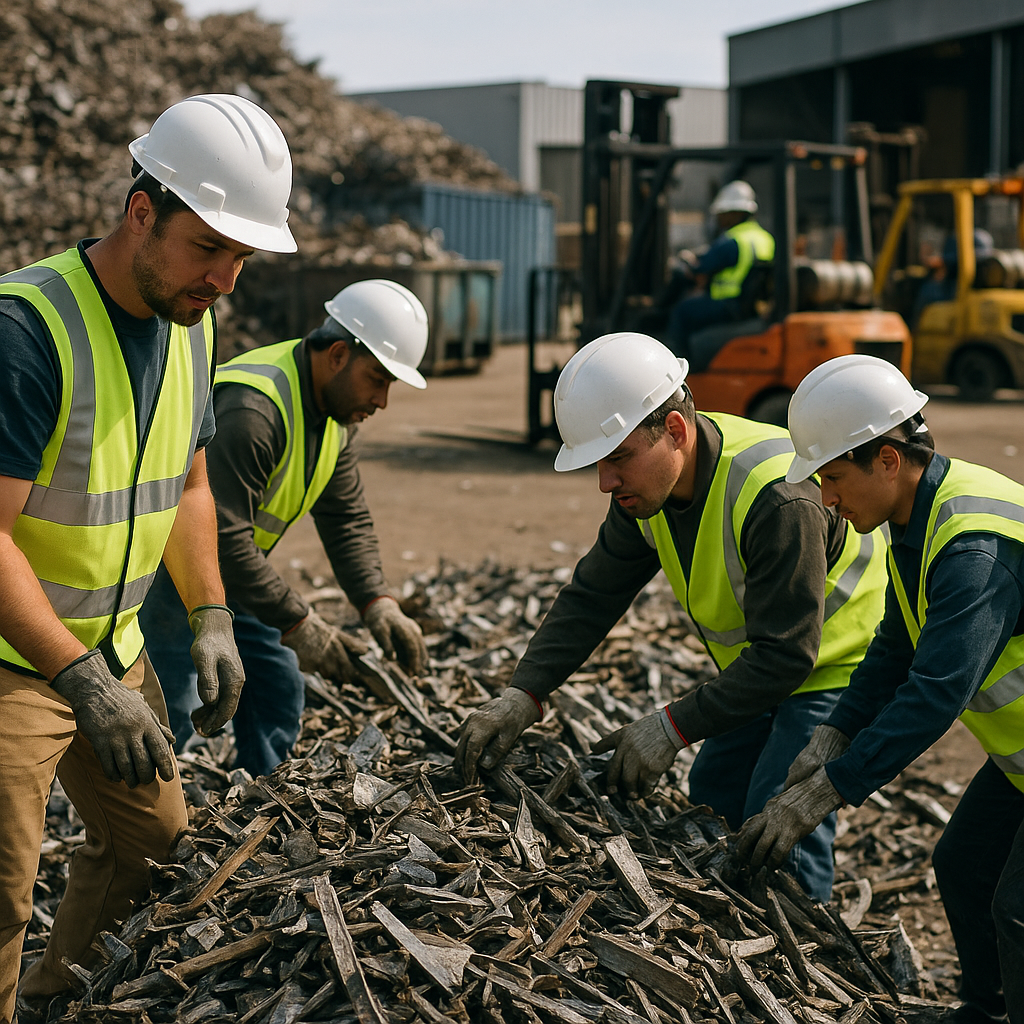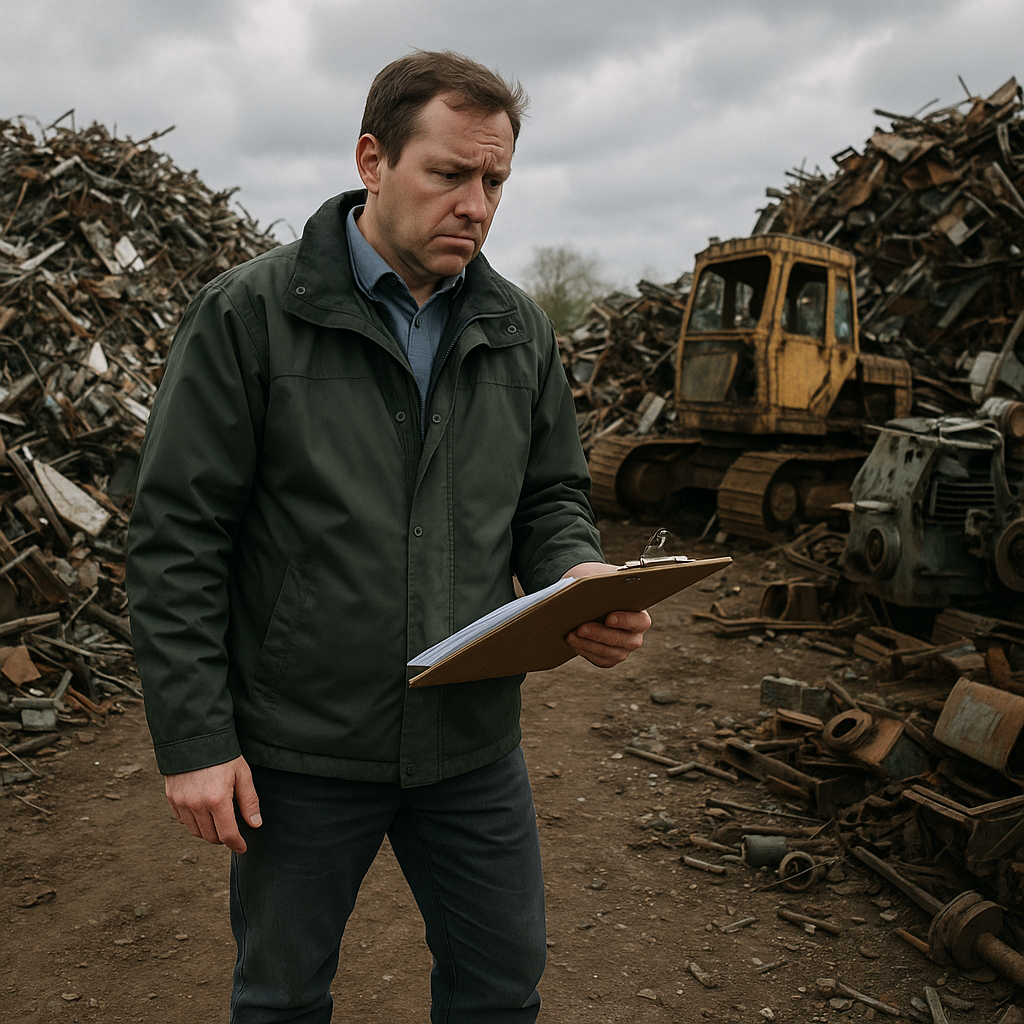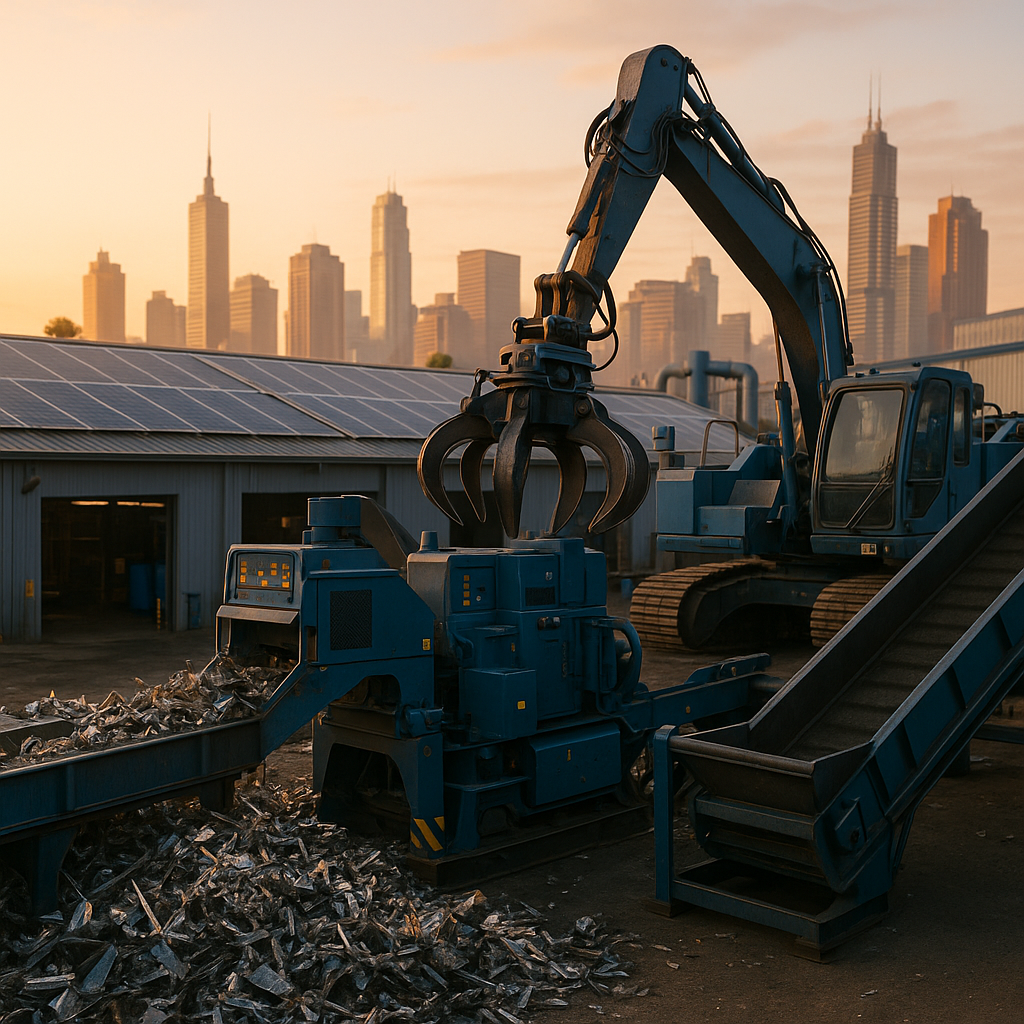5901 Botham Jean Blvd, Dallas, TX 75215
Scrap Metal Consolidation Process: How It Works, Benefits, & Challenges
October 27, 2025Each year, billions of tons of scrap metal are recycled. Traditionally, this valuable resource undergoes an energy-intensive melting and reforming process. However, Scrap Metal Consolidation (SMC) presents an innovative alternative. This process transforms loose scrap metal pieces into usable sheet metal by keeping the material in a solid state.
Unlike conventional methods that require substantial water and energy, SMC is known for its efficiency. It works by applying pressure and specific forming techniques to bind metal pieces without fully melting them. This straightforward approach preserves the material’s integrity while producing new, usable products.
The environmental benefits are significant. SMC can reduce energy requirements for steel recycling by up to 86%. This leads to lower CO2 emissions across the recycling chain and substantially decreases water consumption, addressing major environmental concerns in traditional metal recycling operations.
How Does the Scrap Metal Consolidation Process Work?

Scrap Metal Consolidation (SMC) transforms metal waste into usable sheet metal without the need for energy-intensive melting. This solid-state recycling method uses mechanical bonding and pressure to create new materials directly from scrap. The approach significantly reduces energy consumption while maximizing material recovery.
The SMC workflow includes several key stages that prepare and transform scrap metal:
Preparation Phase
Before consolidation can occur, scrap metal must be properly prepared through several mechanical processes:
- Cleaning and Sorting – Contaminants such as oil, paint, or non-metallic materials are removed, and metals are sorted by type to ensure consistent material properties.
- Shearing and Cutting – Large pieces are cut down to manageable sizes using industrial shears, creating uniform pieces for further processing.
- Shredding – Scrap is fed through shredders with rotating blades, breaking down the metal into smaller fragments with increased surface area for better bonding.
- Baling – Loose metal fragments are compressed into dense blocks called bales, making them easier to handle and transport.
- Briquetting – Similar to baling, but typically used for smaller metal chips and turnings, forming small, dense metal blocks.
Consolidation Techniques
Once properly prepared, the scrap undergoes one or more consolidation methods:
- Roll Bonding – The prepared scrap is fed between heavy rollers under high pressure. As the material passes through, the pressure breaks surface oxides and creates metal-to-metal contact, forming solid bonds between particles. The scrap exits as a bonded sheet with enhanced structural integrity.
- Hot Compaction – Scrap is heated below its melting point and subjected to high pressure. This process softens the metal, allowing better deformation and bonding while maintaining the solid state.
- Powder Metallurgy Approach – For some applications, scrap is pulverized into powder form, compacted under pressure, and then sintered (heated below melting temperature) to create solid bonds between particles.
Finishing Operations
After consolidation, the material often undergoes additional processes:
- Heat Treatment – Controlled heating improves the mechanical properties of the consolidated material by relieving internal stresses.
- Secondary Rolling – Additional rolling passes may be performed to achieve the desired thickness and surface quality.
- Surface Treatment – Depending on the intended application, surface treatments may be applied to enhance corrosion resistance or appearance.
Benefits of Solid-State Recycling
The SMC process offers several advantages over traditional melting-based recycling:
- Energy consumption is reduced by up to 60-80% compared to conventional melting and casting.
- Direct transformation from scrap to product eliminates multiple processing steps.
- Lower temperatures preserve alloying elements that might otherwise be lost during melting.
- Carbon emissions are significantly reduced due to lower energy requirements.
The consolidated materials can achieve 95-99% density compared to conventionally processed metals, with mechanical properties comparable to traditional products. This makes SMC products suitable for various applications where full density isn’t critical or where controlled porosity is beneficial.
| Step | Description |
| Cleaning and Sorting | Contaminants like oil, paint, or non-metallic materials are removed, and metals are sorted by type. |
| Shearing and Cutting | Large pieces are cut into manageable sizes using industrial shears. |
| Shredding | Scrap is fed through shredders to break down the metal into smaller fragments. |
| Baling/Briquetting | Loose metal fragments are compressed into dense blocks or small blocks for handling and transport. |
| Roll Bonding | Heavy rollers apply high pressure, breaking surface oxides and bonding particles into sheets. |
| Hot Compaction | Scrap is heated below its melting point, softening the metal for better deformation and bonding. |
| Powder Metallurgy | Scrap is pulverized, compacted under pressure, and sintered to create solid bonds between particles. |
The SMC technique represents an environmentally sound approach to metal recycling, preserving resources while reducing the carbon footprint of metal production. As energy costs rise and environmental regulations tighten, these solid-state recycling methods are gaining increased industrial attention.
What Are the Environmental Benefits of Scrap Metal Consolidation?
Scrap Metal Consolidation (SMC) offers a groundbreaking approach to metal recycling, providing substantial environmental benefits compared to traditional methods. It achieves an impressive 86% reduction in energy consumption for steel recycling. These energy savings directly translate to significantly lower carbon dioxide emissions during the recycling process.
Traditional metal recycling requires considerable energy for melting operations, contributing to greenhouse gas emissions that exacerbate climate change. SMC eliminates the need for energy-intensive melting processes, resulting in a much smaller carbon footprint. The EPA has consistently identified metal production as a significant source of greenhouse gas emissions, making SMC’s benefits particularly valuable for sustainability goals.
Water conservation is another crucial environmental benefit of SMC. Conventional metal recycling and production processes demand substantial water resources. The National Institutes of Health reports that traditional methods consume up to 40% more water than recycling alternatives. SMC further minimizes water usage, helping preserve this vital resource, especially in regions where water scarcity is a growing concern.
SMC also prevents toxic leaching. When metals sit in landfills, harmful chemicals like lead and mercury can seep into soil and groundwater. By efficiently processing and consolidating scrap metal, SMC keeps these materials in productive use, preventing contamination of natural ecosystems and protecting both wildlife habitats and human water supplies.
Beyond immediate resource savings, SMC contributes to ore conservation. Recycling metal reduces the need for destructive mining operations, which create excavations that destroy natural habitats and release additional pollutants. By maximizing the efficiency of metal recycling, SMC helps preserve undisturbed landscapes and the biodiversity they support.
The combination of energy savings, reduced emissions, water conservation, and habitat protection makes SMC an environmentally superior option for handling metal waste. As organizations aim to reduce their environmental impact, SMC offers a practical, effective solution with measurable sustainability benefits.
What Are the Challenges in Implementing Scrap Metal Consolidation?

Scrap metal consolidation (SMC) offers significant advancements in recycling technology, but several challenges need addressing for successful large-scale implementation. These issues range from equipment requirements to quality control concerns impacting the entire recycling workflow.
Specialized Equipment Requirements
A major challenge in SMC implementation is the substantial investment needed for specialized equipment. Traditional recycling operations require considerable upgrades to effectively handle the consolidation process.
Heavy-duty machinery such as industrial shredders, balers, and advanced sorting systems are crucial for effective material preparation. These systems often demand significant capital investment, which smaller recycling operations may find difficult to afford.
Maintaining this specialized equipment adds further operational challenges. Regular servicing, replacement parts, and technical expertise are necessary to keep consolidation systems running efficiently, increasing overall costs.
Quality Control Challenges
Maintaining consistent quality in consolidated scrap metal is another critical hurdle. Contamination from mixed metals or impurities can drastically reduce the value and usability of the final product.
Strict sorting protocols are essential when implementing SMC. Without proper separation, impurities and mixed materials increase processing costs and reduce the quality of recycled metals.
Advanced sorting technologies offer solutions to these quality issues. AI-powered systems using sensors, infrared scanning, and X-ray technology can process larger volumes with greater accuracy than manual sorting alone, ensuring higher purity levels in the consolidated metal.
| Contaminant Type | Examples | Impact |
| Non-Metallic Contaminants | Plastics, Rubber, Glass | Release harmful emissions when burned |
| Chemical Contaminants | Paints, Adhesives | Produce toxic fumes and unwanted compounds |
| Cross-Contamination | Mixing of metal types | Formation of unwanted alloys |
| Radiological Contaminants | Radioactive materials | Pose serious safety and environmental risks |
Infrastructure Integration Difficulties
Integrating SMC into existing recycling infrastructure poses logistical challenges that require careful planning. The traditional recycling workflow must adapt to accommodate the additional consolidation phase.
Many facilities face space constraints when adding consolidation equipment to their setup. The physical footprint required for effective SMC operations can necessitate facility expansion or reconfiguration of current spaces.
Transportation logistics also present challenges. Efficient coordination is essential to prevent bottlenecks in the recycling process as materials move between collection points, sorting facilities, and consolidation centers.
Market Volatility Concerns
Price fluctuations in the metal recycling market create planning difficulties for SMC operations. Market prices can vary by up to 30% in a single month due to global economic trends, trade policies, and supply-demand dynamics.
This volatility impacts investment decisions related to SMC implementation. Abrupt price drops can lead to financial losses when materials are collected and processed at higher price points, complicating long-term planning.
Robust inventory management systems are crucial for handling these unpredictable market conditions. Organizations implementing SMC must adopt flexible operational strategies to navigate price fluctuations effectively.
Handling Different Metal Types and Grades
The diversity of scrap metal materials presents unique processing challenges. Each metal type requires specific handling procedures and consolidation techniques.
Different grades of metals need separate processing streams to maintain their distinct properties and value. This necessitates more complex sorting systems and handling protocols than general recycling operations.
Training requirements increase as operators must develop expertise in identifying and properly processing various metal types. This specialized knowledge is essential for maintaining quality standards throughout the consolidation process.
Conclusion: The Future of Scrap Metal Consolidation

Scrap Metal Consolidation (SMC) significantly advances recycling technology, with major implications for sustainability. By reducing energy consumption, cutting CO2 emissions, and minimizing water usage, SMC aligns perfectly with global environmental goals. This technology is an important step toward a more circular economy in metal production, where resources are used efficiently and waste is minimized.
As technological innovations continue to enhance SMC processes, we can expect greater efficiency and broader applications across the metal recycling industry. The future of scrap metal consolidation promises not only environmental sustainability but also economic growth through job creation and reduced manufacturing costs. For businesses, municipalities, and sustainability professionals facing stringent environmental standards, SMC offers a viable path forward in responsible resource management. For your recycling needs and to learn more about innovative solutions, contact Okon Recycling at 214-717-4083.
